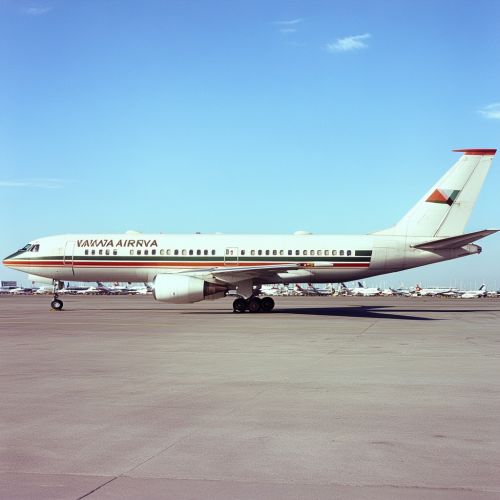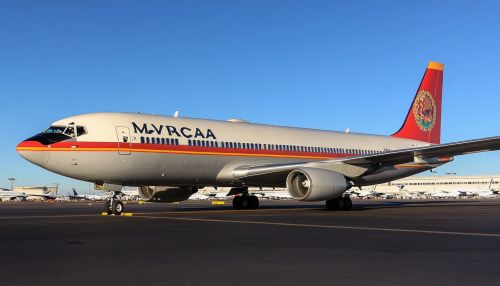Mexicana Airlines: Difference between revisions
(Created page with "== History == Mexicana Airlines, officially known as Compañía Mexicana de Aviación, S.A. de C.V., was established on July 12, 1921, making it one of the oldest airlines in the world. The airline was founded by a group of Mexican businessmen led by Antonio Díaz Lombardo. Initially, Mexicana Airlines operated a single route between Mexico City and Tampico, using a Lincoln Standard aircraft. During the 1930s, Mexicana expanded its operations to include international r...") |
No edit summary |
||
| Line 7: | Line 7: | ||
In the 1960s, Mexicana introduced jet aircraft to its fleet, starting with the Boeing 727. This period marked significant growth for the airline, as it expanded its network to include destinations in North America, Central America, and the Caribbean. The 1980s and 1990s saw further expansion, with the addition of more modern aircraft such as the Boeing 757 and Airbus A320. | In the 1960s, Mexicana introduced jet aircraft to its fleet, starting with the Boeing 727. This period marked significant growth for the airline, as it expanded its network to include destinations in North America, Central America, and the Caribbean. The 1980s and 1990s saw further expansion, with the addition of more modern aircraft such as the Boeing 757 and Airbus A320. | ||
[[Image:Detail-97837.jpg|thumb|center|A Mexicana Airlines Boeing 727 aircraft on the tarmac.|class=only_on_mobile]] | |||
[[Image:Detail-97838.jpg|thumb|center|A Mexicana Airlines Boeing 727 aircraft on the tarmac.|class=only_on_desktop]] | |||
== Fleet and Operations == | == Fleet and Operations == | ||
Latest revision as of 01:09, 1 September 2024
History
Mexicana Airlines, officially known as Compañía Mexicana de Aviación, S.A. de C.V., was established on July 12, 1921, making it one of the oldest airlines in the world. The airline was founded by a group of Mexican businessmen led by Antonio Díaz Lombardo. Initially, Mexicana Airlines operated a single route between Mexico City and Tampico, using a Lincoln Standard aircraft.
During the 1930s, Mexicana expanded its operations to include international routes, becoming the first foreign airline to fly to Los Angeles. The airline continued to grow throughout the 1940s and 1950s, adding more destinations and modernizing its fleet with the acquisition of Douglas DC-3 and DC-4 aircraft.
In the 1960s, Mexicana introduced jet aircraft to its fleet, starting with the Boeing 727. This period marked significant growth for the airline, as it expanded its network to include destinations in North America, Central America, and the Caribbean. The 1980s and 1990s saw further expansion, with the addition of more modern aircraft such as the Boeing 757 and Airbus A320.


Fleet and Operations
Mexicana Airlines operated a diverse fleet of aircraft throughout its history. In its early years, the airline utilized a variety of aircraft, including the Lincoln Standard, Ford Trimotor, and Stinson Model A. As the airline grew, it transitioned to more advanced aircraft such as the Douglas DC-3, DC-4, and DC-6.
The introduction of jet aircraft in the 1960s marked a significant milestone for Mexicana. The Boeing 727 became the backbone of the airline's fleet, serving both domestic and international routes. In the 1980s, Mexicana added the Boeing 757 and Airbus A320 to its fleet, further modernizing its operations.
By the early 2000s, Mexicana's fleet included a mix of Airbus A318, A319, A320, and A330 aircraft. The airline also operated Boeing 767 aircraft for long-haul international flights. Mexicana's fleet was known for its distinctive livery, featuring a white fuselage with blue and green accents.
Destinations and Route Network
Mexicana Airlines operated an extensive route network that included destinations in North America, Central America, the Caribbean, and Europe. The airline's primary hub was Mexico City International Airport, with secondary hubs in Guadalajara and Cancun.
In North America, Mexicana served major cities such as Los Angeles, New York, Chicago, and Miami. The airline also operated flights to several destinations in Canada, including Toronto and Vancouver. In Central America and the Caribbean, Mexicana's network included cities such as San Jose, Guatemala City, San Salvador, and Havana.
Mexicana also operated transatlantic flights to Europe, with destinations including Madrid and London. The airline's extensive route network made it a key player in the Latin American aviation market.
Financial Challenges and Bankruptcy
Despite its long history and extensive route network, Mexicana Airlines faced significant financial challenges in the early 2000s. The airline struggled with high operating costs, increased competition, and economic downturns. In 2005, Mexicana was privatized and sold to Grupo Posadas, a Mexican hotel chain.
However, the financial difficulties persisted, and in August 2010, Mexicana Airlines filed for bankruptcy protection. The airline suspended all operations on August 28, 2010, leaving thousands of passengers stranded and employees without jobs. Efforts to restructure and revive the airline were unsuccessful, and Mexicana's assets were eventually liquidated.
Legacy and Impact
Mexicana Airlines played a significant role in the development of the aviation industry in Mexico and Latin America. As one of the oldest airlines in the world, Mexicana was a pioneer in international air travel and contributed to the growth of tourism and commerce in the region.
The airline's extensive route network connected Mexico with key destinations in North America, Central America, the Caribbean, and Europe, facilitating cultural and economic exchange. Mexicana's legacy is also reflected in its contributions to aviation safety and innovation, as the airline was an early adopter of jet aircraft and modern aviation technologies.
Despite its eventual bankruptcy, Mexicana Airlines remains an important part of Mexico's aviation history. The airline's impact on the industry and its contributions to the development of air travel in the region are remembered by aviation enthusiasts and former employees alike.
